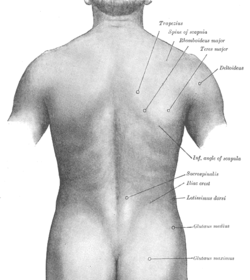Costovertebral angle tenderness


Costovertebral angle tenderness (CVAT), also known as Murphy's punch sign or Pasternacki's sign or Goldflam's sign (Latin: succusio renalis), is a medical test in which pain is elicited by percussion of the area of the back overlying the kidney (the costovertebral angle, an angle made by the vertebral column and the costal margin). The test is positive in people with an infection around the kidney (perinephric abscess), pyelonephritis, hemorrhagic fever with renal syndrome or renal stone. Because the kidney lies directly below this area, known as the costovertebral angle, tapping disturbs the inflamed tissue, causing pain.
This medical test was first described by the American surgeon John Benjamin Murphy in 1884, but in the Post-Soviet states and Eastern Europe, it is often called Pasternacki's sign, after Belorussian internist Fiodor Ignatjevich Pasternacki (1845–1902), who described it during his rounds in a regional hospital in Minsk in 1888. In Poland it is often called Goldflam's sign, after Polish neurologist Samuel Goldflam, who described it in 1900.[1][2][3][4]
References
- ↑ Oh, Timothy T.; Schmitz, Robert L. (1993). The Remarkable surgical practice of John Benjamin Murphy. Urbana: University of Illinois Press. ISBN 0-252-01958-X.
- ↑ Musana KA, Yale SH (August 2005). "Murphy's Sign". Clin Med Res. 3 (3): 132. doi:10.3121/cmr.3.3.132. PMC 1237152
 . PMID 16160065.
. PMID 16160065. - ↑ Musana K, Yale SH (May 2005). "John Benjamin Murphy (1857 - 1916)". Clin Med Res. 3 (2): 110–2. doi:10.3121/cmr.3.2.110. PMC 1183442
 . PMID 16012130.
. PMID 16012130. - ↑ http://www.whonamedit.com/doctor.cfm/2803.html